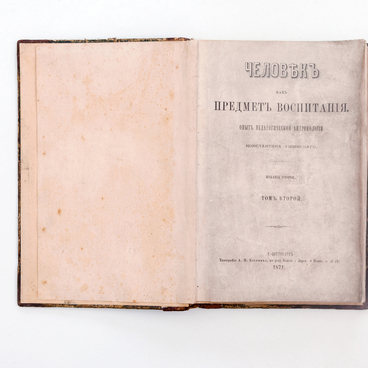The little needle book which belonged to Maria Ulyanova Senior is on the table in her room. It is covered by thick organic glass, which protects the exhibit from damage and decay.
In the 1870s and 80s, Maria Ulyanova, the mother of the family, herself sewed this needle case from cotton thick rep — a dense fabric with a shallow welt formed by the interlacing of the fibers. Such fabric was usually used to reinforce the pockets and sleeves of clothing. The lining of blue silk is fringed around the edges of the book. On the front of the needlebook on the right side, Maria Alexandrovna embroidered a flower, on the left — her initials ‘M.A.U.’. Both designs are enclosed in an embroidered frame. Inside the booklet, Ulyanova placed a scrap of cloth, into which she poked the needles.
Needlepoint is one of the most important accessories for sewing and needlework. Thanks to it, all the necessary needles and pins are always at hand and are not lost during work. The size of the needle case allows you to carry it in your pocket and if necessary, quickly mend something.
After Maria Alexandrovna’s death in 1916, the needle-book was kept by her eldest daughter Anna Ulianova-Elizarova, then by her youngest son Dmitry Ulianov, who gave it to the Central Museum of Vladimir Lenin in Moscow. Already from there in 1952 the needle-book ended up in the Ulyanovsk House Museum of Vladimir Lenin.
Maria Ulyanova, maiden name Blank, lost her mother at an early age. With the other children of the Blank family, her widowed aunt, her mother’s sister, Catherine von Essen, raised her. Maria Alexandrovna was educated at home — she learned French, German, and English knew Russian and European literature, and played the piano. She was good at sewing, embroidery, knitting — this was an important part of a girl’s home education at the time. In 1863, Maria passed an examination for the right to teach, received the title of home teacher, and in the same year, she married Ilya Ulyanov. Maria Alexandrovna gave birth to eight children during the marriage, but only six survived — Anna, Alexander, Olga, Vladimir, Dmitry, and Maria.
In the 1870s and 80s, Maria Ulyanova, the mother of the family, herself sewed this needle case from cotton thick rep — a dense fabric with a shallow welt formed by the interlacing of the fibers. Such fabric was usually used to reinforce the pockets and sleeves of clothing. The lining of blue silk is fringed around the edges of the book. On the front of the needlebook on the right side, Maria Alexandrovna embroidered a flower, on the left — her initials ‘M.A.U.’. Both designs are enclosed in an embroidered frame. Inside the booklet, Ulyanova placed a scrap of cloth, into which she poked the needles.
Needlepoint is one of the most important accessories for sewing and needlework. Thanks to it, all the necessary needles and pins are always at hand and are not lost during work. The size of the needle case allows you to carry it in your pocket and if necessary, quickly mend something.
After Maria Alexandrovna’s death in 1916, the needle-book was kept by her eldest daughter Anna Ulianova-Elizarova, then by her youngest son Dmitry Ulianov, who gave it to the Central Museum of Vladimir Lenin in Moscow. Already from there in 1952 the needle-book ended up in the Ulyanovsk House Museum of Vladimir Lenin.
Maria Ulyanova, maiden name Blank, lost her mother at an early age. With the other children of the Blank family, her widowed aunt, her mother’s sister, Catherine von Essen, raised her. Maria Alexandrovna was educated at home — she learned French, German, and English knew Russian and European literature, and played the piano. She was good at sewing, embroidery, knitting — this was an important part of a girl’s home education at the time. In 1863, Maria passed an examination for the right to teach, received the title of home teacher, and in the same year, she married Ilya Ulyanov. Maria Alexandrovna gave birth to eight children during the marriage, but only six survived — Anna, Alexander, Olga, Vladimir, Dmitry, and Maria.



